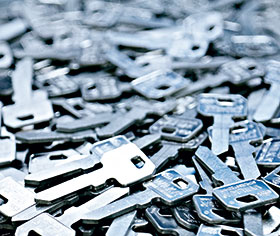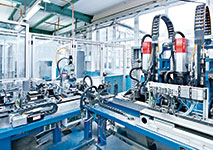

Millions of people have held keys from Wilka in their hands. Problem-free keys and locking cylinders are taken as a matter of course everywhere, without giving thought to the demanding production processes involved. Lock and key products in fact require very efficient and high precision production technology which even compensates for temperature fluctuations of a few degrees. Aumat and AST have developed systems to address these needs with PC-based control from Beckhoff. This ensures manufacturing precision of 0,01 mm as required by the key industry, while enabling easy implementation of customised special machinery – all with minimal engineering effort.
Production of custom orders is typical for the key industry and for specialist, Wilka Schliestechnik in Velbert, Germany. Technical director, Olaf Witte explains: “We mass produce with a lot size of 1. While an order can cover 1000 identical items, each one is usually different – all the way down to a single order for a duplicate key.” Production at Wilka is correspondingly flexible in its structure, with a great variety of special machines developed by Aumat Maschinenbau in Solingen, Germany, together with system integrator, AST in Wuppertal.
According to Achim Ihlefeld, technical director at Aumat, the fundamental requirement for specialised machines is the high degree of precision when machining the key blanks. He says: “The maximum key tolerances lie in the hundredth of a millimetre range. In order to reliably meet this tolerance, the mechanical engineering has to be better by another order of magnitude. This requires the shortest possible control cycle times and servo axes with very high precision. Both of these can be implemented quite well with PC Control from Beckhoff, so that even several parallel milling cycles can be achieved with several corresponding servo axes.” Tim Themann, software developer at AST, adds: “The precision requirements are so high that even temperature fluctuations of a few degrees can be critical for the machining results. PC Control regulates this influence via continuous temperature monitoring.”
Key production line modernised with two stand-alone machines
The advantages of PC-based control are apparent in a Wilka production line for keys, which – according to AST managing director, Wilfried Wengenroth – consists of two stand-alone, specialised machines. An existing key cutting machine for cutting the key bit was overhauled and equipped with control and drive technology from Beckhoff. Added to this was a profile milling machine, likewise controlled via PC Control, for the milling on the key side. The keys are manufactured to order during the run, first getting the longitudinal profile, then the notches. They are then finally delivered with the associated locks.” Ihlefeld adds: “With the two Beckhoff controllers, Wilka benefits from a uniform user interface; if necessary, the company can continue running the second machine without interruption in the case of a machine stoppage.” The cutting machine has nine servo axes while the profile milling machine has 23 servo axes, which are implemented via AX5000 Servo Drives and AM3000 servomotors. Both machines are interlinked and communicate via two gateways programmed in C#. These each run on a C6930 control cabinet Industrial PC (IPC) on the corresponding machine and communicate via ADS with TwinCAT automation software. In addition, the IPCs are in charge of data transfer to the central data server of Wilka. According to Ihlefeld, each milling spindle on the profile milling machine also has its own tool management: “In this way, the four milling spindles manage with 12 cutters each, in order to carry out the many and varied longitudinal milling operations from the thin master key to the thicker special keys that only fit specified locks of a locking system. Conventionally, hundreds of specific cutters are provided for this purpose. In our case we avoid this by intelligently coordinating usage of the 48 cutters via the tool management system.” Themann adds: “Tool management is implemented via TwinCAT NC I. This way, it is not only possible to select the appropriate cutters, but also to cut ideal lines. Therefore, you can have a smoothed edge between deep and flat milling notches lying next to one another, and the finished key is reliably prevented from improperly catching in the lock cylinder.”
Integrated PC Control: the ideal foundation for Industry4.0
“The specialised machines from Aumat have been using PC-based control from Beckhoff since 2005,” says Wengenroth. “At AST, we’ve been working with it since 2004. In this context, EtherCAT is also a critical advantage, specifically due to the ability to perform automatic scanning of the system, in particular during initial commissioning. Additionally, EtherCAT offers rapid and convenient diagnostics of all bus devices.”
Mark Straka, manager of electrical mainten-ance at Wilka adds: “Our evolved controller landscape is by nature heterogeneous, but we have invested about seven years now in making the move to Beckhoff technology. Along with the high computing power, the openness of the system is a vital benefit for us. The older legacy control technology can be integrated without great expense and the higher-level corporate network can be connected just as easily. The latter is increasing in importance to ensure that the entireproduction infrastructure is available via a standard network, from order entry to production, all the way to service.”
In this way, the ideal prerequisite is given for the implementation of Industry 4.0 concepts. According to Witte there is one important aspect that should not be forgotten in this regard: “The more production relies on networking, the more serious the potential damage can be in the case of malfunctions. What good does highly flexible, lot size 1 production do when the systems are down? Therefore, system availability and control technology service are becoming even higher priorities for us. In the case of Beckhoff, this works quite well and quickly.” Straka also confirms this: “The speed with which we respond to inquiries is often crucial for us. After all, production downtime can be very expensive. However, this is not only true in the case of service or procuring replacement parts. Just as critical is the speed with which Beckhoff has developed technical innovations over the years and accompanied those innovations with project support. Meanwhile, there is hardly an application that cannot be solved with PC Control. In addition, with the compact and modular system we save up to 50% in control cabinet space and about 20% in hardware costs compared to conventional PLC technology. Moreover, it is possible to respond rapidly and flexibly to new requirements via EtherCAT Terminals or Box modules, such as for subsequent temperature compensation.”

Scalable, application-specific automation technology
At the key production line, PC Control handles all automation technology tasks: control of machine operation, HMI for setup and automatic operation, fault message display and data archiving, data handling via gateways as well as NC control of the 3-axis milling gantries. Five 3-axis stations controlled by TwinCAT NC I are used for the profile milling machine, while three stations are used for the key cutting machine. Added to this is key transport via 15 transfer stations and the supply of the key blanks with a total of 32 servo axes handled by AX5000 drives with system integrated safety functions. This is all controlled via one C6930 control cabinet IPC per machine, which is connected to a CP6902 38 cm built-in Control Panel for visualisation programmed using TwinCAT PLC HMI. According to Wengenroth, it offers sufficient power even for future system expansions:
“The high computing power and fast control tasks allow us to solve very challenging assignments, such as high-precision drilling control or in the case of broaching machines, tool breakage monitoring implemented via acquisition of the motor current,” he says.
The TwinCAT Database Server offers additional benefits from PC-based control technology. It can be used to process very large data quantities without reducing the PLC cycle times.” The universal EtherCAT-based data acquisition – either centralised or decentralised depending on your requirements – offers further advantages either via EtherCAT Terminals in the control cabinet or directly on-site in the process via EtherCAT-capable valve terminals and with EP1008 or EP2028 EtherCAT Box modules.
Considerable savings through One Cable Technology
Since 2014, Aumat machines have consistently relied on Beckhoff’s One Cable Technology (OCT). This unites power supply and feedback systems in a standard motor cable and significantly reduces hardware and commissioning costs. As Straka confirms: “OCT gives us a tremendous advantage when building a system, in particular due to the reduced labour requirements and sources of potential errors. In addition, the number of cables is cut in half and there is more compact, more scalable cable routing, which by itself makes up about 30% of the cost savings.” Wengenroth sees two further benefits: “With the very stable data transfer in OCT, EMC is no longer an issue. Another plus is the fact that OCT can be easily and rapidly parameterised. The tremendous savings in work time and material therefore reduce engineering requirements on the part of programmers,” he concludes.
For more information contact Kenneth McPherson, Beckhoff Automation, +27 (0)11 795 2898, kennethm@beckhoff.com, www.beckhoff.co.za
| Tel: | +27 11 795 2898 |
| Fax: | 086 603 6868 |
| Email: | info@beckhoff.co.za |
| www: | www.beckhoff.com |
| Articles: | More information and articles about Beckhoff Automation |
© Technews Publishing (Pty) Ltd | All Rights Reserved